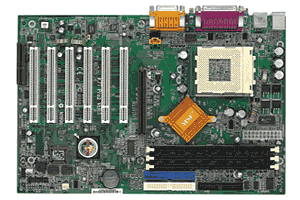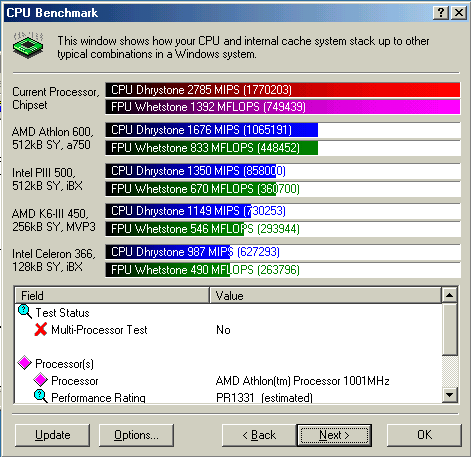
MSI K7T Pro 2-A Motherboard Review

Posted: 1/21/2000
Written by: MotoŽ
The MSI K7T Pro 2-A is a socket A motherboard based on VIA KT133 chipset, which allows 100Mhz FSB speed. On the board, it features 6 PCI, 1 AMR, 3 DIMM slots, and a 4x AGP slot. In addition, the board supports UDMA 100, and comes with onboard AC'97 sound.
To keep cost down on the K7T Pro 2-A, MSI used the VIA KT133 chipset instead of the newer KT133A chipset. Being the only difference between the KT133 and the KT133A is the 133A's ability to run CPU's at 133MHz bus and higher, the performance increase may not justify the price. Aside from that one missing item, the K7T has all the goodies we have come to expect from MSI.
The K7T Pro 2-A is as jumperless A motherboard as you can get. Nearly everything is controlled by the BIOS. There are only two actual jumpers. One for clearing the CMOS data and the other for choosing which language (Chinese or English) you want the diagnostics to be spoken in. The K7T Pro 2A is also one for the very few motherboards on the market which let you adjust the multiplier in the BIOS. This feature is useless unless you have an unlocked Duron or Thunderbird CPU. However, unlocking one of these processors is pretty easy to do.
With net vendors selling the K7T Pro 2-A for as low as $110, this Socket motherboard is an amazing value given all the features offered. You'll be hard pressed to find another motherboard from any manufacturers offering this much stuff for so little.
MSI K7T Pro 2-A Motherboard Review

| k7T Pro 2-A | ||
| CPU: Socket A for AMD Athlon /Duron processor and supports 600MHz ~ 1.2GHz or higher processor |
||
| Memory: Supports 3 168-pin unbuffered DIMM using 6 memory banks, maximum memory size of 1.5GB, and 3.3v SDRAM DIMM |
||
| Slots: 1 AGP slot supports 1x/2x/4x, 1 CNR, 6 PCI and supports 3.3v/5v PCI Bus Interface |
||
| Audio: Chip Integrated |
||
| Form
Factor: ATX Form Factor |
||
| BIOS: Provides "Plug & Play" and DMI function which records your mainboard specifications |
||
| Chipset: VIA KT133 chipset (552 BGA) with FSB 200MHz, AGP 4x and PCI advanced high performance memory controller and supports PC100/133 SDRAM & VCM. VIA VT82C686B chipset (352 BGA) supports enhanced power management features, integrated super I/O, Dual bus Master IDE Ultra DMA 33/66/100, DirectSound AC'97 and ACPI |
||
| Additional
Features: Fuzzy Logic 3; Smart D-LED; Live BIOS |
||
| On-Board
IDE: An IDE controller on the VIA vT82C686B chipset and can connect up to 4 IDE devices |
||
| On-Board
Peripherals: 1 floppy port supports 2 FDD with 360K, 720K, 1.2M, 1.44M and 2.88Mbytes; 2 serial ports; 1 parallel port; 4 USB ports; 1 IrDA, 1 Audio/Game port |
||
The package is pretty complete. You even get a nice MSI sticker to put on your PC. Also the motherboard box turns into a calendar!
MSI K7T Pro 2-A Motherboard Review
The layout of the MSI K7T Pro2A is very well done. There was only one gripe I had and that was with the placements of those big caps near the CPU socket. Those caps made the installation of the CPU cooler a bit difficult. Mind you the caps are far enough away from the CPU socket that it won't interfere with the installation of really big heatsinks like those from Alpha or Global Win. You will just have to be extra careful. The last thing you want to do is break off a cap while trying to install the cooler.
With the exception of the caps, I really can't say enough about how well laid out the K7T Pro2A is. The power connector is placed high up on the motherboard and doesn't interfere with anything. The three DIMMs are right next to the IDE and floppy connectors. The board is a pleasure to work with.
Ahhh yes! No more ISA! The K7T Pro 2-A gives you six PCI slots. More than enough for even the most demanding gadget guy. It's also good to see MSI has moved the Modem Riser slot to the bottom. The AGP slot has an additional bracket attached to support extra long AGP cards. That would have been useful for the next Voodoo card but since nVidia now owns 3dfx, oh well.
While the Pro 2-A's younger brother, the Pro2, was released too early to incorporate ATA100, the Pro2-A wasn't. Built in ATA100 support is a great feature to have, especially if you don't want to purchase a separate controller card.
The MSI K7T Pro 2-A comes with two main diagnostic tools. The first is the Smart D-LED which aids the user in identifying problems by speaking to them, in either English or Chinese, through the PC Speaker! While this is very useful, the more sophisticated solution to a problem would be to use the built on Diagnostic LED system, a group of four lights that are either green or red. The patterns of green and red can be checked with an included information table to determine the problem. This single device makes finding and solving initial system problems extremely useful. All green means you're ready to rock!
MSI K7T Pro 2-A Motherboard Review
The MSI K7T Pro 2-A was tested with the following system:
AMD Thunderbird 700
Micron PC-133 SDRAM
IBM 30 Gig ATA100 Hard Drive
Creative GeForce2 GTS
Creative Sound Blaster Live! Value
First of all I have to say this is one stable motherboard to use if you're an overclocker. When overclocking AMD CPUs it's always best to do so with multiplier adjustments instead of fooling around with bus speeds. This is because the KT133 chipset is not stable at anything over 112Mhz. With that in mind I took my unlocked Thunderbird 700 and proceeded to increase the multiplier in the BIOS till I got this.

1001Mhz! Has a nice ring to it doesn't it? The only other Athlon motherboard able to do the same feat was the much more expensive Abit KT7-RAID.

As you can see, the Multi-Media benchmark is right up there with the best of the best.

If there is one area where the K7T Pro 2-A falls short is memory performance. There are some memory tweaks in the BIOS but it's not as much as what can be found in the Abit KT7-RAID. As a results, the K7T Pro 2-A lags the Abit KT7-RAID by up to 30%.
MSI K7T Pro 2-A Motherboard Review

MSI has done a great job with the K7T Pro 2-A. This motherhboard shows the MSI desire to improve their products. MSI is known to produce high quality products and K7T Pro 2-A is no exception. MSI even went so far as making the box the motherboard came in useful. After installing the motherboard, you can turn the motherboard box into that cool calendar you see at the top. One can view this as a good way to keep your name in front of your users or MSI marketing going overboard.
The board has all the overclocking features needed for overclocking an AMD CPU. The most important being multiplier changing and Core tweak. The stability is one of the best I've ever experienced. Although MSI engineers used some pretty big capacitors for signal filtering that doesn't affect the space around the socket so installing a big Alpha cooler is really not a problem. You just have to take your time and do it nice and easy.
The K7T Pro 2-A is an ideal overclocker's motherboard for someone who don't want to pay an arm and leg. Besides the ability to adjust bus speed and multiplier, there is also voltage adjustments of up to 1.85V. If that can't make your TBird or Duron stable, nothing will.
With a street price of around $110, the MSI K7T Pro 2-A is one of the best, if not the best, bang for the buck motherboard you can buy. This motherboard speaks value. But it's not value at the expense of performance or features. Nearly every feature one can hope for in a motherboard is here. You would expect to pay a lot more for this type of motherboard.
There is almost nothing to gripe about with the K7T Pro 2-A. The only thing I can think of is moving those big caps further away from the CPU socket but that is minor. Memory performance could be better as well but that may be fixed with future BIOS updates.
Those seeking ultimate performance and features regardless of price will want to stick with the Abit KT7-RAID. For the value minded overclocker, the MSI K7T Pro 2-A is the way to go. Hats off to MSI for an amazing piece of work.
The Goods
Great price
Terrific feature set
Jumperless
Built ATA/100
Super stable when overclocked
Cool LEDs
The box turns into a calendar!
The Bads
Memory performance could be better
Caps are close to CPU socket
Rating: 9.5/10